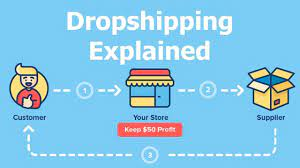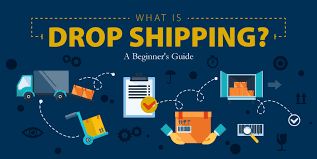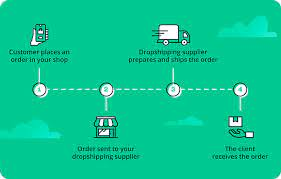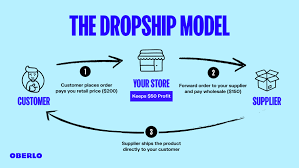
Dropshipping is an increasingly popular order fulfillment method for e-commerce businesses. Dropshipping is a fulfillment process that involves a retailer partnering with a supplier who ships products directly to customers. This means that the retailer does not need to store inventory or handle shipping, making it a convenient and cost-effective order fulfillment option for businesses that sell online of all sizes.
At our company, drop shipping can be an intelligent strategy for e-commerce businesses to streamline their supply chain and operations and increase profitability. In this article, we will delve into the details of overhead costs and benefits of drop shipping and offer some tips on how to get a successful business started with this fulfillment method.
What is dropshipping?
As mentioned, dropshipping is a fulfillment method in some e-commerce retailers where a retailer partners with a supplier to ship products and fulfill customer orders. When a customer orders on the retailer’s website, the dropshipping supplier is notified and sends the product directly to the customer. This means that the retailer does not need to store inventory or handle shipping, which can save time and money.
One of the critical benefits of the business concept of dropshipping is that it allows businesses to offer a wider variety of products without the risk of stocking excess inventory. Additionally, since the retailer does not need to handle the shipping costs, they can focus more on marketing and customer service.
How does dropshipping work?
To start dropshipping, a retailer typically needs to find a supplier willing to partner with them. Many other dropshipping companies, supplier directories, and platforms are available to retail stores and online that can help with this process.
Once a retailer has found a supplier, they will typically integrate their website with the supplier’s system. This allows the e-commerce retailer to import product information and images and receive automatic updates on product quality, inventory, and shipping.
When a customer orders on the retailer’s website, the supplier is notified and ships the product directly to the customer. For fulfilling customer orders, the retailer pays the supplier for the product, usually at the retail price or a discounted rate. The supply chain keeps the difference as profit.
Is dropshipping right for your business?
While dropshipping can be a convenient and cost-effective order fulfillment method, it is not necessarily suitable for every business. Some of the critical factors to consider when deciding whether to use dropshipping for the online order fulfillment process of your business include the following:
Product variety: If your business offers a wide range of products, dropshipping may be a good option for avoiding excess inventory and storage costs.
Profit margins: Since the benefits of dropshipping often involve paying a discounted rate for products, it can be an excellent way for small businesses to increase profit margins.
Brand control: If you are concerned about maintaining control over your brand, dropshipping may not be the best option since the supplier will be responsible for shipping and handling.
Shipping times: Since the supplier is responsible for handling fees due for shipping, it can be difficult for multiple suppliers to guarantee fast shipping times, which may concern some customers.
Tips for successful dropshipping
If you decide to use dropshipping for your business, some key strategies can help ensure success:
Choose top store owners and reliable suppliers: Look for a complete store owner with the store owners good reputation for quality products and timely shipping.
Focus on marketing: Since you won’t spend as much time on inventory and shipping, you can focus more on marketing and building your brand.
Optimize your website: Make sure your website is optimized for conversions, with clear calls to action and easy navigation.
Offer excellent customer service: Since you rely on the supplier for shipping and handling, it is essential to offer excellent customer service to the customer’s expectations. No supplier errors ensure customer satisfaction.
In conclusion, the dropshipping model can be an intelligent fulfillment method for e-commerce businesses to streamline operations and increase profitability. By partnering with a supplier, many e-commerce companies can offer a wider variety of products without the risk of excess inventory saving time and money on shipping fees and handling. However, it is essential to carefully consider the pros and cons of the dropshipping process before deciding whether it is suitable for your business. If you decide to use the dropshipping method, choose a reliable supplier, focus on marketing, optimize your website, and offer excellent customer service to ensure success. With these strategies in place, dropshipping can be a valuable tool for growing your e-commerce business.
To sum up, if you are considering implementing drop shipping for your own e-commerce business, it is important to research, weigh the pros and cons, and carefully choose a reputable supplier. With the right approach, dropshipping can be a powerful tool for increasing profitability and growing your e-commerce business.

Dropshipping: An Efficient Way to Start Your E-commerce Business
Starting an e-commerce business can be challenging, especially if you don’t have the resources to buy and store your inventory. However, a dropshipping business model allows you to sell products without purchasing merchandise or holding any physical stock. This article will explain what a dropshipping business model is, what dropshipping is and how it work, why it works, and how you can start your own dropshipping business.
What is Dropshipping?
Dropshipping is a retail fulfillment method where a store or online storefront doesn’t keep the products it sells in stock. Instead, when a store sells a product through the billing process of dropshipping legally, it purchases the item from a third-party supplier and has it shipped directly to the customer. As a result, the seller never sees or handles the product.
Dropshipping has become a popular way to start an e-commerce business because it eliminates the need for a warehouse to store inventory. It also allows sellers to offer a wide range of products without purchasing them upfront.
How Does Dropshipping Work?
Dropshipping works as follows:
- You create an online store and list products for sale.
- A customer places an order in your store.
- You forward the order to your supplier and the customer’s shipping address and payment.
- The supplier ships the product directly to the customer with your branding on the packaging.
- You keep the difference between the price you charged the customer and the price you paid the supplier.
You act as a middleman between the customer experience and the supplier. Your role is to do market research and sell the products while the customer experience and supplier handle inventory management and shipping.
Advantages of Dropshipping
Dropshipping has several advantages over traditional e-commerce models:
Low Startup Costs
Since you don’t need to purchase inventory upfront from other sellers, dropshipping has lower startup costs than other e-commerce business models. You only need a website, payment gateway, and supplier to start your dropshipping contracts.
Wide Product Range
Drop shipping allows you to sell a wide range of products without purchasing them upfront. This allows you to offer your customers a broader selection of products, which can increase your sales.
No Inventory Management
Since you don’t handle the inventory, you don’t need to worry about storing, shipping complexities organizing, or managing it. This frees up your time to focus on marketing and growing your business.
Flexibility
Dropshipping allows you to work from anywhere worldwide as long as you have an internet connection. This makes it a flexible online business model you can operate from home, traveling, or a coffee shop.
How to Start a Dropshipping Business
Starting a dropshipping business involves several steps:
1. Choose Your Niche
The first step in starting a dropshipping business is to choose your niche. Your niche should be a product category you’re passionate about with enough demand and enough profit margin potential.
2. Research Your Competitor
Once you’ve chosen your niche, you need to research your competitors. Look at their pricing, product quality, selection, customer service, and marketing strategies. This will help you identify opportunities to differentiate yourself and stand out.
3. Find a Supplier
Finding a reliable dropshipping supplier is critical to the success of your dropshipping business. Look for top dropshipping suppliers who offer high-quality products, competitive pricing, and fast shipping times. You can find these dropshipping suppliers on marketplaces like AliExpress or dedicated to dropshipping sellers on platforms like Oberlo or Sprocket.
4. Create Your Website
Once you have your niche, competitors, and supplier, you can create your website. Your website should be visually appealing, easy to navigate, and optimized for conversions.

5. Set Up Your Payment Gateway
You’ll need to set up a payment gateway to process payments on your website. Popular payment gateways for dropshipping and e-commerce businesses include PayPal, Stripe, and Shopify Payments. Make sure to choose a payment gateway that is secure, easy to use, and compatible with your e-commerce platform.
6. Launch Your Store
Once you’ve set up your website and payment gateway, you’re ready to launch your online store. Start promoting your store through social media, email, and other digital marketing channels. Monitor your sales and customer feedback closely, and adjust your marketing and product offerings as needed.
7. Scale Your Business
As your dropshipping business grows, you may want to consider scaling your operations. This could involve expanding your product selection, optimizing your website for search engines, or investing in paid online advertising elsewhere. With the right strategies and execution, you can build a profitable and sustainable dropshipping business.
Dropshipping is a popular e-commerce business model allowing you to sell products without holding inventory. Following the steps outlined in this article, you can start your own dropshipping retail business and compete with other e-commerce websites. Remember to choose your niche carefully, research competitors, find a reliable supplier, create a compelling website, and market your dropshipping e-commerce store effectively. You can build a successful dropshipping e-commerce business and achieve your entrepreneurial dreams with persistence and hard work.

Why Dropshipping is a Great Business Model
Dropshipping is an excellent business model for entrepreneurs who want to start an online store without managing inventory, fulfillment centers, or shipping and logistics costs. Here are a few reasons why the dropshipping model is a great business model:
Low Startup Costs
Dropshipping requires minimal startup costs compared to other e-commerce business models. You don’t have to buy inventory upfront or rent a warehouse to store your products. Instead, you can focus on creating a compelling website and promoting your products through digital marketing channels.
Easy to Scale
Since you don’t have to worry about managing inventory, the dropshipping model is easy to scale. You can expand your business structure and product offerings without worrying about storing additional inventory or increasing shipping costs.
Flexible Location
With drop shipping, you can run your business from anywhere worldwide with an internet connection. This flexibility allows you to work from home or travel while managing your business.
Wide Product Selection
Since you’re an e-commerce store and not a retail store, limited by physical inventory, you can offer your customers an online shopping experience with various product quality products. This allows you to cater to niche markets and offer unique products that other retailers or e-commerce websites may not offer.
Low-Risk
Dropshipping carries a lower risk compared to other e-commerce business models. You don’t have to worry about buying inventory upfront, which can be a significant financial risk if your products don’t sell.
How to Start a Dropshipping Business
Here are the steps to start a dropshipping business:
1. Choose Your Niche
The first step in starting a dropshipping business is to choose your niche. Focus on a specific category of products you’re interested in and have a high demand. Conduct market research to identify the competition and demand for your chosen niche.
2. Research Your Competitor
Once you’ve chosen your niche, research your competitors to identify their strengths and weaknesses. Analyze their product offerings, pricing, and marketing strategies to identify ways to differentiate your business.
3. Find a Reliable Supplier
The success of your dropshipping business depends on finding a reliable supplier. Look for suppliers that offer competitive pricing, high-quality products, and reliable shipping. You can find suppliers through online directories, trade shows, or by contacting manufacturers directly.
4. Create a Compelling Website
Your website is the face of your dropshipping and other business models, so creating a compelling, easy-to-navigate, and visually appealing website is essential. Choose a user-friendly e-commerce platform, such as Shopify or WooCommerce, and customize it to reflect your brand’s identity. Then, optimize your website for search engines using relevant keywords and meta tags.
Tips for Success
Here are a few tips for running a successful dropshipping business:
1. Focus on Customer Service
Customer service is crucial for all dropshipping companies and businesses. Ensure excellent customer service by responding promptly to inquiries and resolving customer communication issues quickly.
2. Monitor Your Metrics
Monitor your website’s traffic, sales, and conversion rates regularly. Use this data to identify improvement areas and optimize your marketing and product offerings.
3. Stay Up-to-Date with Trends
Stay up-to-date with the latest industry trends and product offerings. Continuously research and test new products to keep your offerings fresh and unique.
4. Stay Compliant with Regulations
Make sure to comply with all applicable regulations, such as data privacy laws and product safety regulations. This will help you avoid legal issues and protect your customers’ data.
Following these steps and tips, you can start a successful dropshipping business and outrank other e-commerce websites in search engine rankings.

How to Optimize Your Dropshipping Business for Search Engine Rankings
Optimizing your dropshipping store or website for search engine rankings can help you attract more traffic and increase sales. Here are a few tips on how to optimize your dropshipping store or business for search engine rankings:
1. Conduct Keyword Research
Keyword research is the process of identifying the keywords and phrases that your potential customers are using to search for products online. Use keyword research tools such as Google Keyword Planner or SEMrush to identify relevant keywords for your niche.
2. Optimize Your Product Pages
Optimize your product pages by including relevant keywords in page titles, descriptions, and meta tags. Use high-quality images and product descriptions to showcase your products and make them stand out from your competitors.
3. Create High-Quality Content
Creating high-quality content such as blog posts, how-to guides, and product reviews can help you attract more traffic to your website. Make sure to include relevant keywords in your content and provide value to your readers.
4. Build Backlinks
Backlinks are links from other websites that point to your website. Building backlinks can help you increase your website’s authority and improve your search engine rankings. Reach out to other websites in your niche and ask for a link back to your website.
5. Use Social Media
Social media platforms such as Facebook, Twitter, and Instagram can help you attract more traffic to your website. Share your products and content on social media and engage with your followers to build a loyal customer base.
6. Optimize for Mobile
Optimizing your website for mobile devices is crucial for improving your search engine rankings. Make sure your website is mobile-friendly and loads quickly on all devices.
7. Monitor Your Analytics
Monitor your website’s analytics to track traffic, conversion rates, and other essential metrics. Use this data to identify areas for improvement and optimize your website for better search engine rankings.
Following these tips, you can optimize your dropshipping business for search engine rankings and outrank other e-commerce websites in search engine results pages. Remember that search engine optimization is an ongoing process, so continuously monitor and improve your website to stay ahead of the competition.
CoopBusiness is a revolutionary cooperative business-building platform that empowers individuals to become entrepreneurs, business owners, and financially independent.
As a member, you’ll receive top-level business mentorship, access to our proprietary business systems, and the opportunity to access the funds you want to turn your business ideas into reality.